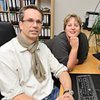The golden oranges from Oranienbaum

This proximity to the kingdom dates back to the 17th century. In 1659, John George II, Prince of Anhalt-Dessau, married the Princess Henriette Katharina of Oranienbaum. From this developed diverse contacts of both an economic and cultural nature. Aletta Jaeckel explains how the city and castle of Oranienbaum were built in accordance with the plans of the Dutch architect Cornelius Ryckwaert for Katharina from 1663. At the start of this year, the native Dutchwoman founded her company, AJC Tourismusmarketing, in Halberstadt.“We want to continue such traditions and reanimate them today,” adds Emiel Hondelink. The management consultant with Dutch roots has lived in Saxony-Anhalt for 15 years. For him, the Federal state has grown to be his homeland. In 2008, he was one of the initiators of the Netzwerk Niederlande-Mitteldeutschland [Netherlands-Central Germany Network], which was founded in the historical site in Stolberg. The castle there is the birthplace of Juliana zu Stolberg (1506-1580), the matriarch of the older and younger line of the Dutch royal house. Hondelink reports that contacts between German and Dutch businesspeople and their affiliates should be at the centre of events ranging from a typical Dutch “Borrel”, a social drink, to major economic conferences.The tall man sees it as a good basis to make successful contacts. Companies, private people, municipalities and hotels are members of the association. The roots of the 39 members are almost equally divided between the two countries. He explains that the economic contacts of Saxony-Anhalt to the Netherlands are considerable. Companies from the region between Altmark and Burgenland are particularly diligent in trade. In the ranking of export countries, the Netherlands is in undisputed fourth place with a proportion of 6.3 percent. In terms of imports, the seven percent mark is almost achieved. Saxony-Anhalt is currently the East-German Federal state with the highest proportion of direct Dutch investment. At least 51 percent of the shares in 151 companies are held in Dutch hands. For example, this includes f|glass in Osterweddingen with 280 employees. Among other things, the company produces coated and/or hardened glass panes. The very white, low-iron glass which is also produced here is used globally in the solar industry. f|glass dates back to a joint venture between the Dutch Scheuten Group and the German Interpane Group. Hondelink sees an opportunity for both sides in these cooperations. “Among other things, we want to promote settlements here in Germany,” affirms the spokesperson of the network. Just at the end of last year, 23 potential investors from the Netherlands were in the Federal state. They were particularly surprised by the cheap prices of land. “Perhaps we will manage to set up a glasshouse factory in the south of Saxony-Anhalt for the EsBro investment group,” he says.The framework conditions would be good. The waste incineration plant in Zorbau could provide sufficient heat for the company.According to Aletta Jaeckel, there are lots of chances in tourism and it is not a one-way street. The Netzwerk is currently organising a trip of a dozen tourism experts from Saxony-Anhalt to the Netherlands; some spaces are still free. In February of the coming year, they can advertise their services there, while experiencing “how the Dutch” work. Ultimately, they are among those who feel particularly happy in the Harz, Altmark or in the Saale-Unstrut region. They regularly occupy the top position in the rankings of foreign guests in Saxony-Anhalt. These regions are practically on their doorstep, with just a five hour car journey. The Luther Memorials, the Dessau-Wörlitz Garden Realm and cycling along the River Elbe are popular. In 2012, Jaeckel wants to attract fellow countrymen from her homeland with a first independent travel offer. The tour is called “Harz und Himmelsscheibe” and will tour Goseck, among other places. Here, the holiday-makers will experience the summer solstice on 21st June in the true-to-original reconstruction of the observatorium from 4800 B.C. Of course, a visit to the oldest, concrete depiction of the cosmos, the sky discs of Nebra, is on the agenda in Halle an der Saale. “Such offerings will also provide long-term effects for Saxony-Anhalt,” adds Hondelink. After all, tourists spend money, go to guesthouses, shop and stay in hotels. This secures workplaces and helps the economy in the Federal state.Author/Photo: Klaus-Peter Voigt Contact:Netzwerk Niederlande-MitteldeutschlandTöpferplan 106108 Halle/Saale E-Mail: oeffentlichkeit@nnmd.de Web: www.niederlande-mitteldeutschland.de

